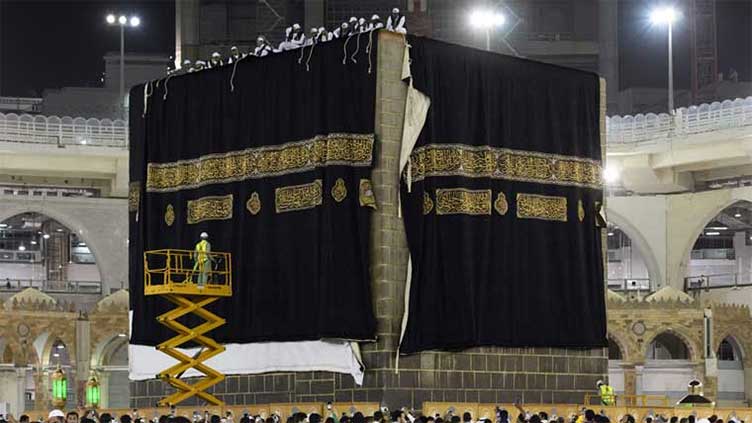Ghilaf-e-Kaaba changed with advent of Muharram

World
The process of replacing Ghilaf reflects deep respect, reverence for Kaaba
(Web Desk) - Ghilaf-e-Kaaba, the Kiswah, has been replaced on the 1st of Muharram 1446. The month of Muharram marks the beginning of the Islamic year.
The ceremony involved the removal of the old Ghilaf-e-Kaaba (Kiswah) and replacing it with a new one.
The annual ceremony to replace the Kiswah, the sacred cloth covering the Kaaba, is taken place on the 1st of Muharram 1446.
This revered tradition, which historically occurred on the day of Arafah during the Hajj pilgrimage, has seen a recent shift in its scheduling.
The Kiswah, an intricate and beautifully embroidered black silk cloth adorned with Quranic verses in gold thread, is a symbol of the Kaaba’s sanctity.
The process of replacing it is a meticulously planned event, reflecting the deep respect and reverence held for the Kaaba, the most sacred site in Islam.
In previous years, the ceremony was held on the day of Arafah, the ninth day of Dhu al-Hijjah, coinciding with the pinnacle of the Hajj pilgrimage.
This timing was symbolic, aligning with the day when millions of pilgrims gathered on the plain of Arafah in prayer and reflection.
However, recent adjustments have moved the ceremony to the 1st of Muharram, the first day of the Islamic New Year.
This change allows the event to stand alone, free from the logistical challenges of the Hajj pilgrimage, ensuring a focused and dignified ceremony.
It also symbolizes a new beginning, aligning the renewal of the Kiswah with the start of the Islamic calendar year.
The process of changing the Kiswah involves a dedicated team from the King Abdulaziz Complex to Manufacturing the Kaaba’s Kiswah.
This facility, located in Makkah, is responsible for the intricate task of creating the Kiswah, which requires months of preparation and craftsmanship.
The fabric is woven, dyed, and embroidered with great care, using around 670 kilograms of pure silk and 120 kilograms of gold and silver threads.
On the day of the ceremony, the old Kiswah is carefully removed and replaced with the new one.
This process takes several hours and involves precision and respect.
The old Kiswah is then cut into pieces and distributed as gifts to dignitaries and religious organisations around the world, continuing the legacy of the sacred cloth.
The ceremony is attended by officials from the Saudi Arabian government, religious leaders, and dignitaries from various Muslim countries.
It is a moment of deep spiritual significance, marking the continuity of tradition and the unwavering reverence for the Kaaba.


